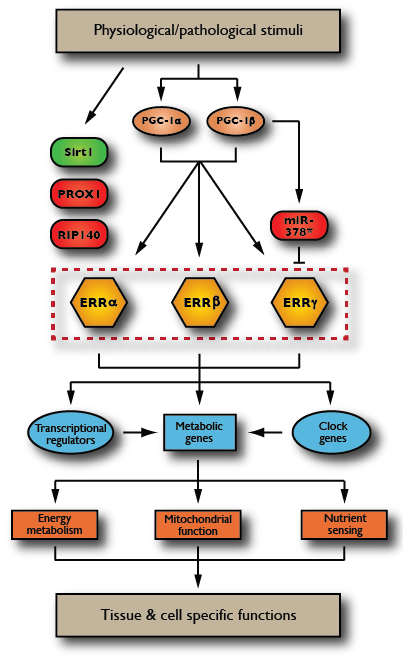The ERRs (Estogen-Related Receptors)
The ERRs (Energy Regulatory Receptors)
Note: Estrogen-related receptors (ERRα, β and γ) were the first orphan members of the nuclear receptor superfamily to be discovered based on their structural and functional kinship with the estrogen receptors (ERs), hence their name. However, biological functions of the ERRs have no direct relationship with estrogen physiology, but rather are associated with the control of cellular energy homeostasis. We therefore propose to change their name to "energy regulatory receptors".
ERRα
ERRα was the first orphan nuclear receptor identified based on DNA and amino acid sequences homology with the classic estrogen receptor. Although ERRα share structural and functional kinship with the estrogen receptor, it is not activated by natural or synthetic estrogens. ERRα functions as a metabolic regulator by modulating the expression of enzymes involved in all aspects of energy metabolism, including all enzymes implicated in the Kreb's cycle, mitochondrial oxidative phosphorylation, lipid synthesis and numerous other biochemical pathways. ERRα is expressed strongly in tissues in all major physiological systems but most notably in tissues with high energy demands such as the heart, skeletal muscle, kidneys and intestine. ERRα dysfunction and abnormal expression has been associated with bone density, type II diabetes, anorexia and several types of cancers. Targeted deletion (knockout) of ERRα results in defects in reduced fat mass, muscle fitness, T cells proliferation as well as hepatic and cardiac functions.
ERRβ
ERRβ was identified coincidently with ERRα. Like ERRα, it is not activated by estrogens but its transcriptional activity can be abrogated by synthetic estrogens such as diethylstilbestrol (DES) and the anti-breast cancer drug tamoxifen. Total knockout of ERRβ results in placental defects and prenatal lethality. Deletion of ERRβ in specific cell types in the inner ear results in defective production of endolymph. ERRβ is expressed at low levels in most tissues with peaks in the eye, kidney, thyroid gland, testis and heart. ERRβ is also expressed in embryonic stem cells and plays a key role in establishing pluripotency.
ERRγ
ERRγ is one of the last members of the nuclear receptor superfamily identified. It is more structurally and functionally related to ERRβ than ERRα, including its response to synthetic estrogens. ERRγ is predominantly expressed in the central nervous system, notably in the brain stem, cerebellum, corpus striatum, olfactory bulb, spinal cord, hypothalamus and pituitary gland. Targeted deletion of ERRγ results in lactatemia, cardiac abnormalities and death shortly after birth.

Mechanism of action:
A model of the ERR-based transcription network controlling mitochondrial biogenesis and function. The transcriptional activity of the ERRs is enhanced by constitutively present PGC-1α or PGC-1β whose expression is turned on after physiological stimuli such as fasting, exercise, or exposure to cold temperatures. The expression of ERRα is then enhanced via an autoregulatory mechanism. ERRα and ERRγ then activate the expression of other transcription factors such as GABPA and PPARα, and together these factors activate vast gene networks involved in mitochondrial biogenesis and function. Coregulators such as SIRT1, RIP140 and PROX1 also participate in regulating the ERR/PGC-1 response.
